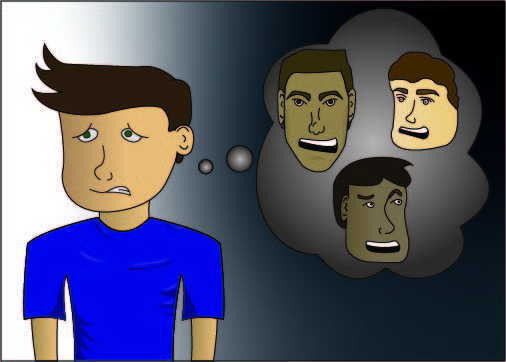What Is Peer Pressure?
October 14, 2020
Within adolescent lives today, most tend to fall under the influence of peer pressure, or in other words, when peers encourage or influence others to change their values, decisions, and behaviors. In fact, in general, students feel pressured by those around them about 49 percent of the time, according to WordPress.com. Issaquah freshman Cal Marshall said that “people pressure others because they want to get them outside their comfort zone and either laugh at them or help them do something they normally wouldn’t do alone.” This is often seen throughout life, and specifically in high school. There are several specific types of peer pressure, including spoken, unspoken, direct, indirect, negative, and positive peer pressure. The first four types mentioned might not seem as familiar or self-explanatory as the last two, but they tend to be used just as often and in similar situations. If a student is verbally encouraging a classmate to skip class with them, that is an example of spoken peer pressure. Unspoken peer pressure on the other hand, is pretty similar to indirect pressure. They both can be described as when someone is exposed to a peer’s actions and behaviors but is not directly told to follow along and has to decide for themselves if they want to hop on the bandwagon. Now, to be simplified into only two categories, instances of peer pressure can either fall into being negative, or positive.
If the effect of peer pressure puts someone in a dangerous situation or brings up discomfort and any negative emotions in them, then it is negative peer pressure. Based on statistics and student comments, this is seen most often within high schools and in social situations. Negative peer pressure can have many effects on a person. When one is forced into doing something they are not comfortable with, it can bring up many emotions and even have a big mental toll on them. After extensive research, according to the American Psychology Association (APA), “Depression is a leading health issue faced by college-going students and peer pressure is one of its several causes.” While reading that information, it may seem like an exaggeration for peer pressure to contribute to mental disorders. But peer pressure is not always a temporary or one-time thing. After even being influenced just once, adolescents may adapt to a different lifestyle, getting involved in drugs, sex, and delinquent behaviors.
When people are asked about peer pressure, it is common for the response to be something similar to Issaquah junior Clare Marshall’s definition: “When either a friend, classmate, or someone older pressures you into doing something that you are not okay with.” This is generally a true statement, but it also is not so black and white. Peer pressure does not only do harm, as it can also help someone in their personal growth. It can encourage them to get out of their comfort zone in a healthy way or guide them towards making smart decisions and motivate them to achieve a goal. If you think about it, mostly everyone can remember a time where they were influenced by a person or by people, and it bettered the outcome of a situation. “Making someone leave a party early when they’ve been drinking and shouldn’t drive home,” said Skyline sophomore Lauren Meyers, is an example of positive peer pressure because “the person could have just saved their friends’ life.” When a person’s intention towards a peer is to guide, inspire, or help them, then that type of pressure is more than acceptable.
Adolescents begin to experience peer pressure as soon as they start to pay attention to what others think about them. For a lot of children, this happens as early as the first grade when children give into the pressure of wanting to be liked and to fit in. However, some children certainly are not as susceptible to the influence of others even while being at that young and naive age. When adolescents are deemed susceptible to falling under the pressure from their peers, it may be because they are craving attention or friends. On the other hand, if one is hanging around somebody who is very persuasive and has a lot of social skills, one may look susceptible to peer pressure when in reality they might not be particularly gullible or susceptible to others at all. Another way that peer pressure arises in adolescents is when a child or teen is surrounded by mostly older kids. This does not resonate with all children of course, but when one is with peers that are older, they might seem cooler to the younger peer, which can initiate them to follow or participate in the things that the older kids do to feel more like a part of the group. In addition, Professor Brett Laurson from Florida Atlantic University states that “paradoxically, being popular may make you susceptible to influence. This one is a little bit up in the air, but it may be that popular kids in some domains worry about protecting their status,”. That means that kids who are higher on the social food chain, so to speak, are more likely to give into doing things that society tells them they should be seen doing, even if they do not want to do them because they fear their heightened status will vanish.
Any child, no matter the clique or social group they fall into, can be influenced and persuaded into doing something they normally would not. During our adolescent years, everyone is searching to find themselves and know who we are as people. But in this time, as our identity is weak, the pull of social acceptance is at its strongest and we as people are at the most risk to fall under the pressure. Humans value conformity when we are individually weak, even though what is needed is authenticity. “We want to fit in when standing out gets us so much more in the long run. We tiptoe our way through life by doing things to please others, not because it’s what we want. Over time our actions, appearances, and lives become a reflection of what others want, not what we want,” says author Chad Bokius from his “Life Lessons on Opinions and Peer Pressure” blog. Peer pressure can be a very complicated thing, and it cannot necessarily be prevented from happening. What can be done, though, is spreading more awareness around sticking up for yourself and embracing differences instead of believing we need to change as individuals. Redmond High senior Adam Roper stated that “students should be taught more about peer pressure, but they should know how it can affect people just from common sense.” Teaching adolescents to have positive intentions for their peers and being considerate with their feelings could help contribute to changing some of the toxic traits of society. Turning those intentions into neutral or positive things, could be extremely helpful and constructive for individuals today.




